- BOAT OF THE YEAR
- Newsletters
- Sailboat Reviews
- Boating Safety
- Sailing Totem
- Charter Resources
- Destinations
- Galley Recipes
- Living Aboard
- Sails and Rigging
- Maintenance
- Best Marine Electronics & Technology


Hunter 41 DS
- By Nim Marsh
- Updated: June 2, 2006
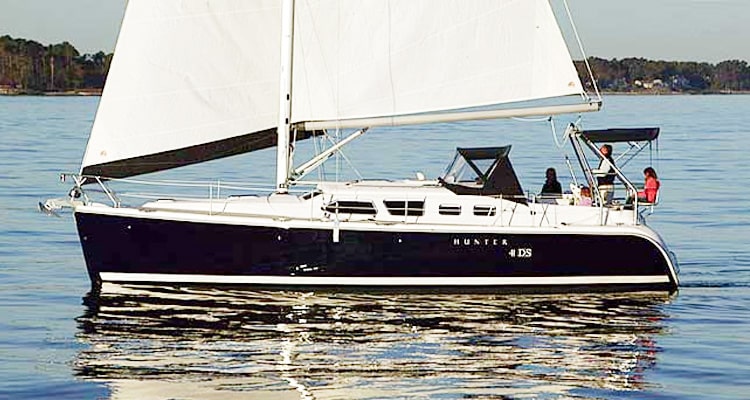
What luck! This blustery fall day on Chesapeake Bay, yacht designer (and Hunter’s director of engineering) Glenn Henderson would sail with us aboard one of his team’s creations, the shoal-draft version of the Hunter 41 DS, a spin-off from the year-old aft-cockpit Hunter 41. We joined the deck-saloon sloop by launch as it luffed up in Eastport’s lee, near the mouth of Back Creek in Annapolis, Maryland. People and gear were quickly pulled aboard, and Henderson was champing at the bit to tell me his baby’s story. “First off,” he said, “I wanted a boat that would have all the systems and conveniences you’d expect in a house and also be capable of long-distance offshore passages.”
I looked down the broad decks–the 41 DS has a 3:1 length-to-beam ratio–held high above the water by substantial freeboard, and I thought that the first part of the wish was eminently possible. But I also wondered, would she sail? So many builders of successful designs have pushed the interior-volume envelope so far that their creations no longer effectively harness the wind.
We cracked off in very light air, heading for the unprotected waters of the bay. I was visibly surprised when the boat-with a modest 17.2 sail area-to-displacement ratio–responded dramatically, accelerating as the optional Selden in-mast furling main and Furlex roller-furling genoa filled. Henderson had been watching for my reaction, and when he got what he wanted, he said, “Sail area/displacement doesn’t always tell the story. Right off the bat, I try to make my hulls easily driven. Of course,” he added with a wry smile, “they put three-bladed props on them, but I can’t do anything about that.”
Coaxing the Coefficients Henderson then explained that with each boat he designs, he tries to push one of the design coefficients: fineness, block (underwater volume compared with a block with the same overall dimensions), midship (the ratio of underwater fullness to that same block amidships), or prismatic coefficient (Cp). For the Hunter 41 and 41 DS, he decided to push the Cp, a mathematical description of how full a boat is in the ends.
“The extremes for sailboats are between .49 and .62,” Henderson said, the higher figure equating to fuller ends. The higher the Cp, the more stable–and sluggish–the hull form. While trying to pick the ideal Cp at one point on the hull and determine an optimal speed-to-length ratio, it occurred to Henderson that the Cp is a single number that defines two different ends but treats them equally. “So I decided to cut the boat in two at max beam and make a graph of stern and bow Cps,” he said. Henderson analyzed the numbers from past Hunters, then extrapolated the ranges to the behavior of the respective designs. “I then could safely take that data and apply more radical treatment [to the 41 DS] and yet be safe that the boat wouldn’t be over the edge,” he said. The numbers he arrived at–lower Cp for the bow, higher for the stern–had the most effect on boat speed and motion.
The boat accelerated well in both light and heavy air, and it got up to speed quickly as we cleared Horn Point and took head-on the full 18- to 20-knot brunt of a northeasterly wind. While the seas weren’t large, they were sloppy and persistent, and the 41 DS coursed easily through them at more than 6 knots, the helm delicate and responsive as we picked our way through wakes and around crab-pot buoys. A stem closer to plumb not only increased the waterline but also reduced pitching.
For Henderson, responsiveness in the 41 DS was an important factor. It’s a “largish” boat, he said, and it’s likely to be carrying a number of passengers, with only one or two familiar with the boat. He wanted to make this boat as maneuverable as possible in crowded situations-wharf areas, marinas, crowded harbors, any tight quarters. The Whitlock direct-drive steering system and balanced spade rudder with a stainless-steel rudderstock certainly help to achieve this. “Responsiveness is also a good attribute when sailing in really rough seas offshore and steering through waves,” he added.
Versatile Deck Layout
Out in the bay, the 41 DS was steady and smooth as we put it through its paces. I’m 5 feet 7 inches tall, and I found the visibility forward, over the dodger, excellent. Where once the mainsheet was led solely to the cabin top, strategic positioning of hardware and winches allows the solo crew to trim from the companionway–or the gregarious skipper with a cockpit full of guests to run the boat from the fantail. The mainsheet can be led from the cabin top and sheeted on the spinnaker winch, creating little interference with the cockpit. When in port, the 40-inch wheel folds out of the way to create more space for socializing.
The side decks are wide and graced with a terrific nonskid pattern. The first time I went to the foredeck, I felt secure, bracing myself on the stout handrails on the dodger and the cabin top. Slippery areas existed, though, around the forward hatch and on the corners and visor of the house.
With 777 square feet of working sail (we sailed with the optional vertical-batten in-mast furling main) on a 19,400-pound displacement, this Hunter isn’t overcanvased. Yet in 13 to 15 knots of wind on a truly messy sea, we logged close to 7 knots of speed, accelerating with every gust but never overpowered. “I’d rather have a boat that’s easily driven and, at the same time, manageable and able to sail in relatively stiff breezes without reefing than one that excels in light airs to the exclusion of high-wind performance,” said Henderson.
The most impressive aspect of the 41 DS was how quickly it was able to accelerate. Henderson said he achieved this by pushing the volume forward so the stern corner was out of the water, which flattened the stern wave. “Hull speed is derived from bow and stern waves,” he said. “If the boat goes too fast and gets too far ahead of the stern wave, it falls into a hole. So, by virtue of an S-shaped curve at the quarters, I artificially induced a wave to form farther aft, which in essence increased the waterline length and the boat speed.”
When I went below on the wide companionway steps, holding on to perfectly positioned grabrails, the ride was smooth and quiet, even though conditions outside were anything but. Later, when we ran the 40-horsepower Yanmar with a conventional shaft at 2,500 rpm, the noise level remained low.
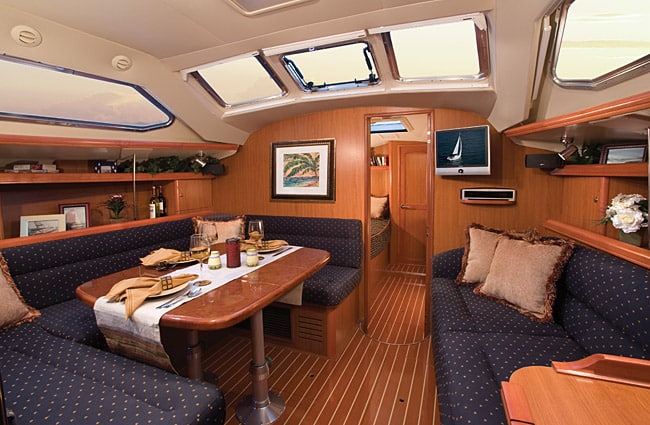
Light and Airy Saloon
Upon entering the saloon, I was struck by the awesome, 6-foot-10-inch headroom and the light and airiness created by the raised deck. Just forward and to port of the steps is the L-shaped galley. Corian countertops (with an inset waste bin and, to protect the dinette, a clear backsplash with rounded edges) are surrounded by high, inward-curved fiddles, which do double duty as grabrails as you prepare meals and approach or descend the companionway. These ergonomic fiddles are found throughout the boat along shelf edges over settees and in the cabins. In the galley, at the stove, a harness will be needed, especially when on port tack.
The double sinks, positioned diagonally in the angle of the L, would take some getting used to while washing up in a seaway. Aft of them is a gimbaled two-burner propane stove and oven, with a microwave set above, and a stainless-steel front-loading fridge. The pantry, with shelves and a deep bin, is worthy of any small home, and there’s in-sole storage for cans and jars. With two opening ports, a hatch, and proximity to the companionway, galley ventilation will be superb. Forward of the galley is the dinette; all three seats could serve as extra berths while on passage, and the table, with telescoping support, converts to a double berth. A vertical stainless-steel grabrail is conveniently located between the galley counter and the dinette.
The aft head/shower stall, with two frosted opening ports, is to starboard of the companionway; just aft of it is the door to the aft cabin, with its athwartships queen berth, private entrance to the head, Corian-topped vanity, cedar-lined hanging locker, and lots of drawers. With two opening ports and a hatch, cross-ventilation will be excellent. The forward-facing nav station, forward of the head, has a radiused, battened seat for comfort and efficiency in a seaway, a lift-top desk with more of those seamanlike fiddles, and a mahogany console on which to mount remote instrument readouts. Opposite the dinette is a full-sized couch, with a large drawer under and, on the boat we sailed, a plasma-TV and sound system over.
The forward cabin, with 6 feet 2 inches of headroom, has a comfy double to port, with fiddled shelves all around and drawers under. To starboard is another cedar hanging locker and a Corian-topped vanity. The head/shower is in the peak and, thus, only usable on a flat sea or in port.
I stepped off this Hunter impressed. The 41 DS seems to cover many bases and includes many details in an attractive package that really works. Apparently, Cruising World’s 2006 Boat of the Year judges also think the Hunter Design Group is on the right track: The 41 DS was voted Best Production Cruiser 40 to 44 Feet (see “Crunching the Numbers,” January 2006).
Also noted by the BOTY judges was Hunter’s attention, throughout the boat, to American Boat & Yacht Council (ABYC) specifications, anticipating, in at least two cases–carbon-monoxide and smoke detectors–future ABYC recommendations. One judge, ABYC curriculum designer and senior instructor Ed Sherman, said, “I think the build quality is much higher in terms of fit and finish. It certainly represents a lot of bang for the buck.”
But for me, it was the Hunter’s performance that stood out, which I reiterated to Henderson. “My primary objectives were high stability, boat speed, a good motion in a seaway, and reactivity or responsiveness,” he replied. “These four attributes make up what is commonly known as ‘performance.'”
Nim Marsh is a Cruising World contributing editor.
HUNTER 41 DECK SALOON
LOA 40′ 4″ (12.29 m.) LWL 35′ 6″ (10.82 m.) Beam 13′ 3″ (4.04 m.) Draft (shoal/deep) 5′ 0″ (1.52 m.)/6′ 6″ (1.98 m.) Sail Area (100%) 928 sq. ft. (86.2 sq. m.) Sail Area (furling) 777 sq. ft. (72.19 sq. m.) Ballast(shoal/deep) 6,612/6,506 lb. (2,999/2,951 kg.) Displacement (light ship) 19,400 lb. (8,800 kg.) Ballast/D (shoal/deep) .34/.33 D/L 194 SA/D (furling) 17.2 Water 100 gal. (379 l.) Fuel 36 gal. (136 l.) Mast Height 60′ 2″/62′ 10″ (standard/furling) (18.34/19.15 m.) Engine 40-hp. Yanmar Designer Glenn Henderson Base Price $201,290
HUNTER RESPONDS
We trust that you, too, will be as impressed as Nim Marsh was, and we feel it appropriate that the Hunter 41 DS not only earned the 2006 Cruising World award for Best Production Cruiser 40 to 44 Feet but also earned the 2006 Cruising World Overall Best Value award.
John Peterson Hunter Marine
- More: 2001 - 2010 , 41 - 50 ft , Coastal Cruising , marlow-hunter , monohull , Sailboat Reviews , Sailboats
- More Sailboats

Sailboat Review: Tartan 455

Meet the Bali 5.8

Celebrating a Classic

New to the Fleet: Italia Yachts 12.98

Bitter End Expands Watersports Program
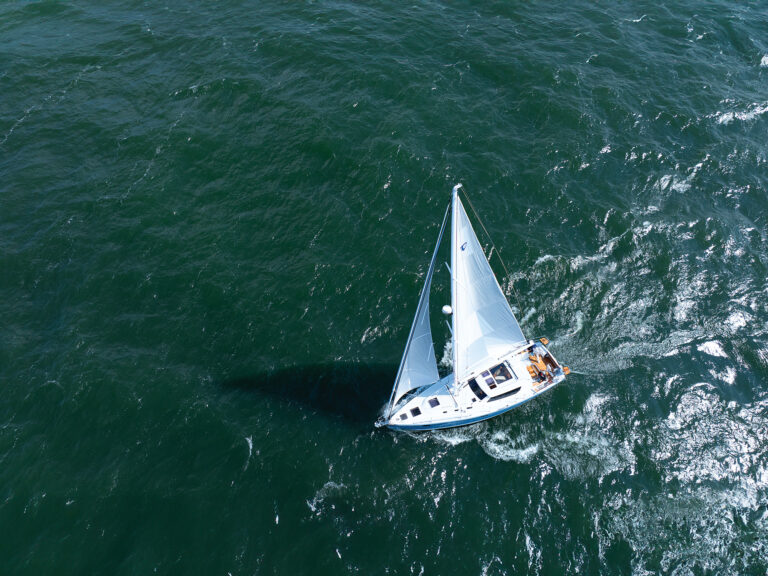
Miracle in a Bowl
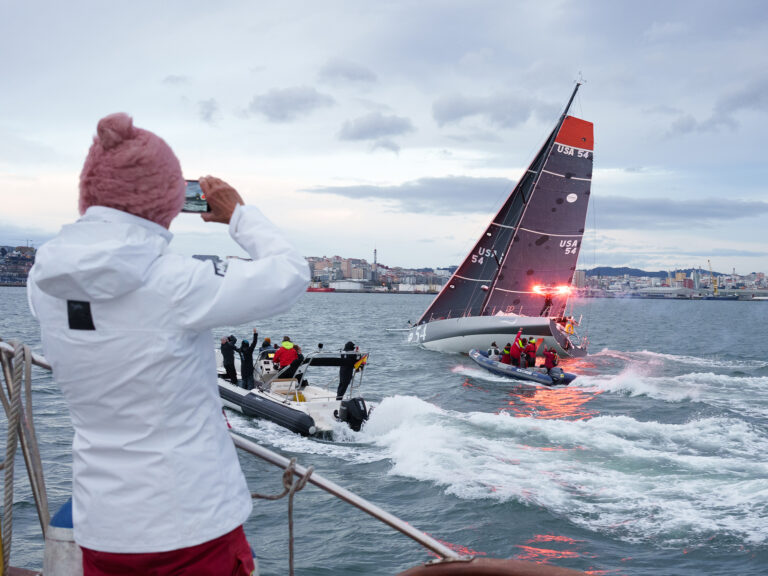
Cole Brauer Completes the Global Solo Challenge
- Digital Edition
- Customer Service
- Privacy Policy
- Email Newsletters
- Cruising World
- Sailing World
- Salt Water Sportsman
- Sport Fishing
- Wakeboarding

- Forums New posts Unanswered threads Register Top Posts Email
- What's new New posts New Posts (legacy) Latest activity New media
- Media New media New comments
- Boat Info Downloads Weekly Quiz Topic FAQ 10000boatnames.com
- Classifieds Sell Your Boat Used Gear for Sale
- Parts General Marine Parts Hunter Beneteau Catalina MacGregor Oday
- Help Terms of Use Monday Mail Subscribe Monday Mail Unsubscribe
Buying a Hunter 41 DS
- Thread starter sailtheworld79
- Start date May 24, 2021
- Tags hunter 41 ds
- Hunter Owner Forums
- Ask A Hunter Owner
sailtheworld79
Hey all!! I’ve got an offer in on a 2006 Hunter 41 DS that’s going to survey in a couple of weeks. My wife and I plan to sail the boat on the Great Lakes, to the Caribbean and then across the Atlantic. I realize that the mere mention of me sailing across the Atlantic in a Hunter is going to stir the pot but I guess I’ll get some laughs out of this from the armchair sailors. My question is whether or not anyone here knows of any serious issues that need to be dealt with on the boat? Improvements? Storage ideas? I’d also love to know if anyone has done any serious cruising in this boat and how it went for them. She seems to be quite comfortable for the two of us with better livability than the Catalina 400 we were also looking at. Any intelligent responses here would be greatly appreciated!!
Welcome to the forum, congratulations making the first step to buy a Hunter 41DS and you will find this a really comfortable cruising boat!!
sailtheworld79 said: Any intelligent responses here would be greatly appreciated!! Click to expand
sailtheworld79 said: Great Lakes, to the Caribbean Click to expand
SEMPERAVANTI41
Hunter 41 DS is a great boat. Sold mine a year ago after owning for 12 years. Docking can be dicey in a cross wind with a bow thruster, really dicey without one. Design of boat limits thrusters' tunnel diameter, so even with thruster docking can be interesting. Boat will sail at anchor, solved problem with Mantus anchor. Still sails but Mantus holds where standard Delta anchor wouldn't. Make sure to tighten and locktite all mechanical bolts, especially propeller shaft and anchor windlass. Both of these let loose!
So, I guess my real question would be: has anyone sailed this boat offshore for extended periods. How did it handle?
kappykaplan
Do a search on this site for postings by "Sequitur". He and his wife sailed from Vancouver to FL, rounding Cape Horn, in a Hunter 49. Their blogs are still at Leaving Sequitur
DayDreamer41
As for the boat handling heavy seas, we are Great Lakes sailors and have been out there in some angry seas in Lake Michigan and Huron and the Sapphire seemed to handle the conditions nicely allowing us to be comfortable and dry, were they 30' walls of water, no, but angry they were, is the Sapphire a full keeled Swan absolutely not, her flat bottom aft and beaminess tend to provide some additional motion but at no time did we ever feel the boat couldn't handle it. I can contest that the righting moment of the Hunter 41DS is about 40 seconds (longest 40 seconds of my life), but the rig stayed standing, the boat righted and we returned to port with the same number of sailors as we left with. We do have a thruster (6" tube/3.5 HP) on our Sapphire which was part of the Mariner package, it does help maneuver in tight spots but it will not move the bow against a cross wind so docking can be tricky given the additional free board these boat have. We have an anchor sail (don't recollect by whom) which helps emmensely with the issue of swinging back and forth when at anchor. The Selden roller furling main has a bearing at the top of the foil which requires annual lubrication, the issue is the bearing is not easily accessible especially with the rig up, one has to remove the mast head to access it, I plan on dropping the rig every second year to lubricate this bearing. Improvement projects complete and on my list: Convert batteries to series parallel 6 volt Trojans T105's (check) Upgrade charging system to a Balmar 150A with Balmar external regulator (check) Convert alternator V-belt drive to serpentine belt (check) Remove engine belt guard to improve airflow over alternator (check) Drop mast, dimantle furling system rebuild and lubricate (check) Convert interior lights to LED (check) Add the optional gas shock to the vang allowing for easier use (check) Convert the loveseat in front of the nav station to a bench seat with lee cloth and partitioned storage underneath Convert forward head to a wet locker (never use this head, not sure why a boat of 40' needs (2)) Find a method to bring the main sheet back to the helm, for a couple of reasons, most importantly to allow ready access when at the wheel, secondarily to reduce the resistance on the line so that downwind deployment is more easily accomplished. If I were planning on cruising on the big water I would be changing a few things, like adding a water maker, adding additional fuel capacity (possibly repurposing one of the water tanks), changing the head to use seawater for flushing, add a "Y" valve to divert to overboard discharge (current system is a macerater pump which pulls from the waste tank), We love our Sapphire, she is comfortable, seaworthy and easily sailed by the admiral and I, the small head sail makes for easy tacking and the roller furling main allows for endless adjustment of sail area. Welcome to the SBO forums and hope this helps you.
I have a Hunter 41DS, 'model year' 2009, around when they switched from laminated teak to the laminated vinyl interior. And also switched from lead keels to iron. Meanwhile, has been a good boat. I am mostly live aboard and coastal cruising but she handled herself quite well during a few days of choppy (35kn wind, 4-sec wave period) off of Oregon a couple of years ago. As all of us that own 'production' boats, craftsmanship and quality are always a concern. Pros: The boat is built mostly 'grid style' without the 'pan' so you can actually get to most of the hull from inside if you need to. Exceptions are the aft/fwd cheesy head/shower areas. Which makes sense. Cons: Boat design works well, structural integrity over the long term is definitely not there if you want do 5-years around the world or something. Advice: As always - buy the right tool for the job depending upon your use cases.
I coastal cruise on my 410. Fantastic coastal cruiser. Have been in 6-8 ft seas, not great. Cannot imagine the boat in larger seas, or me for that matter. There are reasons blue water boats are constructed the way they are. They are better equiped to handle larger seas for extended periods of time. Will your 41 make it accross the ocean - yes. Will it be as safe and comortable as a full keel blue water boat - no. Would recommend you do some coastal cruising and experience some large seas before you make the commitment to cross the big pond and once there are committeed. Wish you the best.
Also, it seems a lot of people do buoy racing, coastal cruising and are actually quite good sailors but simply do not realize the ocean is a different thing. With modern technology (in particular weather predictions) it is far safer than it used to be. Meanwhile, the wind, the waves, the chaffing and constant working of gear is much different. My first 'offshore' adventure was taking a 30 footer in the Vic-Maui way back in 1992. I think we were the last boat to do that under sextant. Yes, back then meeting all the race requirements and boat inspections the standard stuff like life rafts, multiple water tanks, SSB, on and on, were required - GPS still was not. I was in graduate school back then so the budget was very tight. We spent as much money kitting the boat out for that race (along with lots of labor) as we did on buying the boat originally. Anyway - another thing to try out that people don't seem to do is hit websites like crewbay or similar and find a couple that is looking for extra hands on a long passage. Jump on the airplane, jump on the boat and help them out. If you are lucky there will be a little bit of interesting weather and a mix of upwind/downwind and you will be on an experienced boat. After a week or so transit you will be in a far better position to know what to look for in a boat and whether you even want to do things like ocean passages at all.
Not to say that you 'can not' take a Hunter41DS across the Atlantic and back. In fact, I might take mine over to Hawaii and back when I have some free time in a couple of years. And there are plenty of folks that do that kind of thing and even are out there for sustained cruising on a wide variety of 'production' boats. It is simply that the boat is not designed for doing these kinds of things on a sustained basis. And this is not 'hunter bashing' - I think they make a great product (at least this particular model) but naturally they are targeted towards the 95% of the buyers that want something fun, comfy, and primarily for coastal cruising with occasional short transits.
It amazes me how close DAYDREAMER41 and myself we did almost the same changes to the sailboat. I am near Cancun but on the gulf part, puerto Progreso, a normal day is a wind from 18 knots up to 35. The longest nav was 200 miles in very bad weather. The boat pound very hard on the waves because is very flat so are all the new design. I think the only problem with this boat crossing ocean is how unstable is with waves, for me is almost impossible to do things below in bad weather, but i never feel unsafe. With the roller main is a blessing how easy is to go at a pace you like, i have been sailing with only the main heavely rolled in and doing 5.5 knots. Above that speed the boat is became very hard to live on, you have to grab on something, now my passage time are calculated at 4 knots. Going upwind with the skoal draft is a nightmare, forget it, but i love the 5 foot draft. I have friends with same size and age benateau, they are much much faster, but inside mine has no rival. I find the 2 helms new setting very unprotected to the elements, with heavy wind and rain i feel much more protected with the center wheel position. buts that is only my 5 cents...
i manage to install 4 trojan lp 16 6 volts below the nav seat.
Thanks for all the replies! I restore and deliver boats for a living and I know I've got a few things to change and upgrade on this boat. I ended up buying Renogy 4Ds and a 31 for the starting batt. I got the hybrid gels and 600 watts of solar. Time will tell if its sufficient. I'm probably going to reinforce some structural areas with Kevlar and epoxy and reinforce the bow section. As for the flat bottom I know she's going to pound a bit and probably roll a bit in a beam sea but its the overall volume and comfort of this boat that sold us. Well, that and the price. If I have to be semi uncomfortable for three weeks doing a major crossing I'm ok with that knowing I'll be comfortable when I get there. We're gonna start in the lakes and then go down the coast and to the Caribbean to see what works and what doesn't then decide where to go from there. I've copied the upgrade lists you gents gave me and I'll work through them - thanks! I'll be posting some photos soon and probably starting a new thread. I'm finding info on this particular model to be somewhat hard to come by so I'd like to continue expanding on it for future owners. If there are any other quirks about the boat you guys could share it'd be much appreciated!
The forward 1/4 of the 41 DS already has Kevlar laid in her
And with the Kevlar sorta-reinforced bow, they also installed the 'factory recommended' bow thruster tubing. Where the factory is Lewmar and the tube itself is not actually structurally sufficient. In particular, it is a spiral wind so can be subject to cracking far easier than a cross-laid FRP pipe. Don't ask me how I found that one out. And yes, given the tight spaces in there it is very difficult to repair.
I still like the boat, for sure. Just not something I feel confident doing any extensive ocean voyaging short handed.
Attachments

- This site uses cookies to help personalise content, tailor your experience and to keep you logged in if you register. By continuing to use this site, you are consenting to our use of cookies. Accept Learn more…
Great choice! Your favorites are temporarily saved for this session. Sign in to save them permanently, access them on any device, and receive relevant alerts.
- Sailboat Guide

- Hunter Marine
Warren Luhrs, founder of Hunter Marine began in the boat building business, first with his father and brother at Henry Luhrs Sea Skiffs and then Silverton Sea Skiffs. Both companies were quite successful. Being an avid sailor, Luhrs had the idea of applying production line efficiencies to the sailing industry. In 1973, the first Hunter sailboat was launched. This was the HUNTER 25, designed by John Cherubini. This boat, as well as may models that followed were extremely well received. Hunter Marine soon became a major force in the sailboat industry. Luhrs became involved in single handed ocean racing and set many records aboard Thursday’s Child and Hunter’s Child. These floating test beds became the basis for many of the innovations that have appeared in Hunter production models. These include B & R rigs, arches and water-ballast. Hunter was sold in August 2012 to Mr. David E. Marlow, builder of Marlow Yachts.
Associations
- JY 15 Class
- Moorings Yacht Charter
- Chuck Burns
- Cortland Steck
- Glenn Henderson
- Hunter Design
- Hunter Design Group
- Hunter Design Team
- John Cherubini
- John Cherubini/Bob Seidelmann
- J. Robert Seidelmann
- Rod Johnstone
- Warren Luhrs
98 sailboats built by Hunter Marine

Hunter 25 Box Top

Hunter 50 CC

Hunter 36 Legend
Hunter 45 wk.

Hunter 27 Edge

Hunter 25.5
Hunter 40.5 legend, hunter 41 ds.

Hunter 30-2
Hunter xcite.

Hunter 37.5 Legend

Hunter 33.5
Hunter 22-2.

Hunter 40-2

Hunter 32 Vision

Hunter 35 Legend WK

Hunter 19-1

Hunter 43 Legend

Hunter 41 AC
Hunter 35 legend wk + 246.


Hunter 40-1

Hunter 27-2

Hunter 45 DS

Hunter 29.5

Hunter 42 Passage CC

Hunter 35 Legend

Hunter 450 Passage

Hunter 31-2

Hunter 26.5
Marlow-hunter 31.

Hunter HC 50

Hunter 37 Legend

Hunter 36-2
Hunter 33-2, hunter 22 fixed keel.

Hunter 28.5

Hunter 18.5

Hunter 426 DS

Hunter 45 CC
Moorings 335.

Moorings 295
Hunter 50 ac.

Hunter 35.5 Legend

Hunter 23.5

Hunter 19-2

Hunter 27-3

Hunter 45 Legend

Hunter 36 Vision

- About Sailboat Guide
©2024 Sea Time Tech, LLC
This site is protected by reCAPTCHA and the Google Privacy Policy and Terms of Service apply.
Big Board Gaming
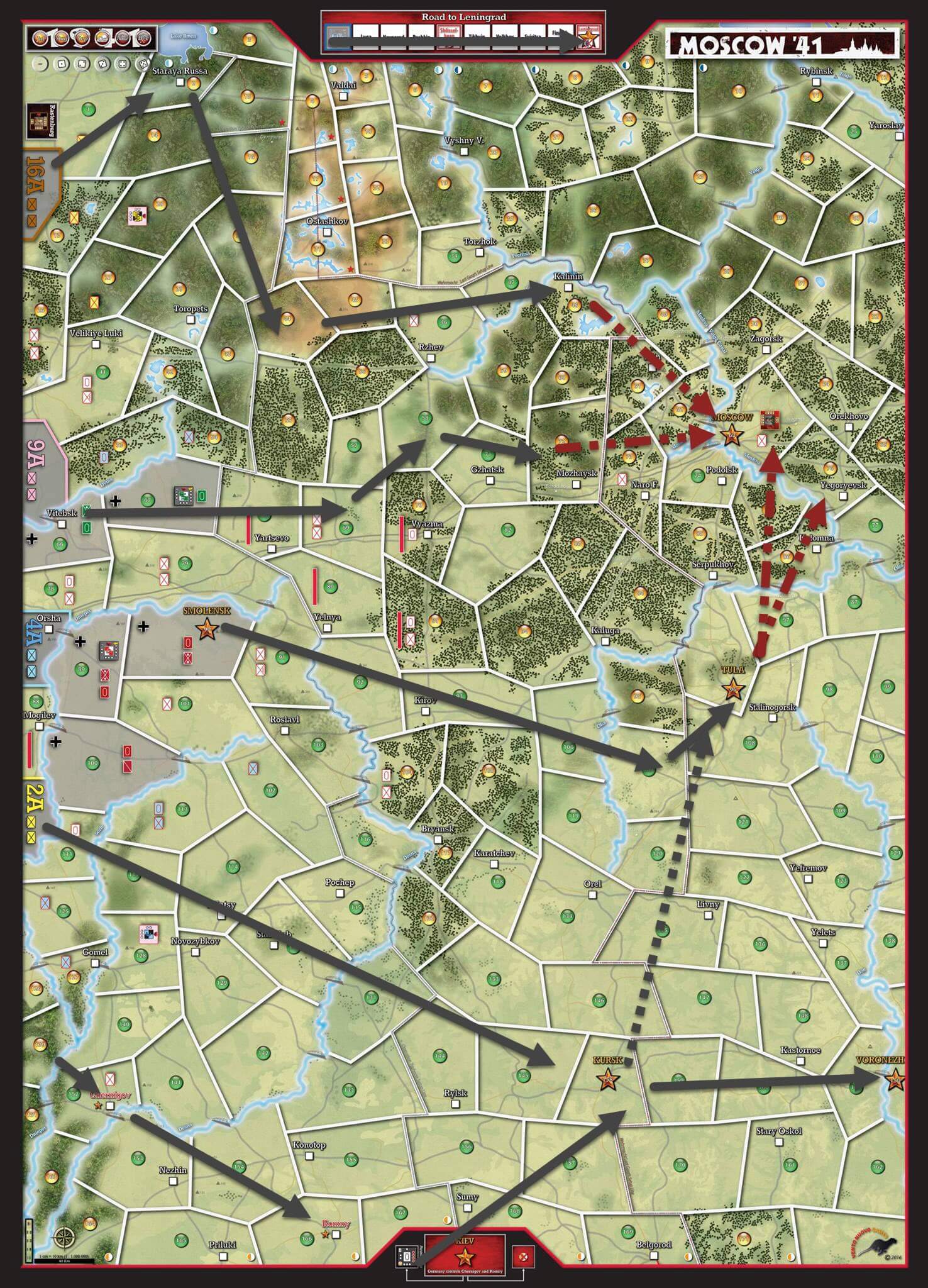
Moscow ’41
Opening moves matter.

So it seems. The shrink rip was fun. The components excellent. The stickering easy (latex stickers that can be moved removed for the OCD). Now with rules read we attempt to grok this game.

First thing to note is that we skip the Logistics phase in Turn 1. CHECK!
Then we assess the board and look for cheap ways to isolate the enemy and attrit via careful attacks that allow break thru or blitz & exploit movement.
But wait. The Nazis have no air…You got to pull reinforcements to get it. two blocks in 28 are the Luftwaffen HQ.,…seriously. I check in on BGG.
“why is air not available at start? Why is it a random draw? I have 2 chances in 25 28 of drawing a HQ for air. So really this is forcing you to take reinforcements impulse one…”
“ that’s probably the main german concern for the first impulse..
Historically the LF was just a bit behind the Dnieper, and had to cross it and prepare airfields before the Wehrmacht spearheads could count on the precious air support.
After seizing Smolensk, on July 16, only Guderian and Hoth were on the eastern bank and ready to push, even if short of fuel and facing serious afv breakdown issues.
They tried to close the pincer around Smolensk to trap the already beaten 16th, 19th and 20th Soviet Army, while the 4th and 9th Army were still engaged in reducing the Minsk pocket and avoiding flooding of escaping Soviet troops towards the Pripet marshes.
However, once again, there was a hole open in the east, as Guderian moved eat instead of North-east, and Hoth was forced to dispatch one of his Panzer Corps northward to seize Velikie Luki.
While some of his Generals wanted to go straight forward, Hitler was afraid of leaving too many gaps between his Army Groups, and for this reason he committed the only reserve available – the Weich’s second army – to fill the gap between AGC and AGS and wanted the 16th army to go on for Toropets (and that’s the reason we wanted this army – formerly under AGN control – in the game.
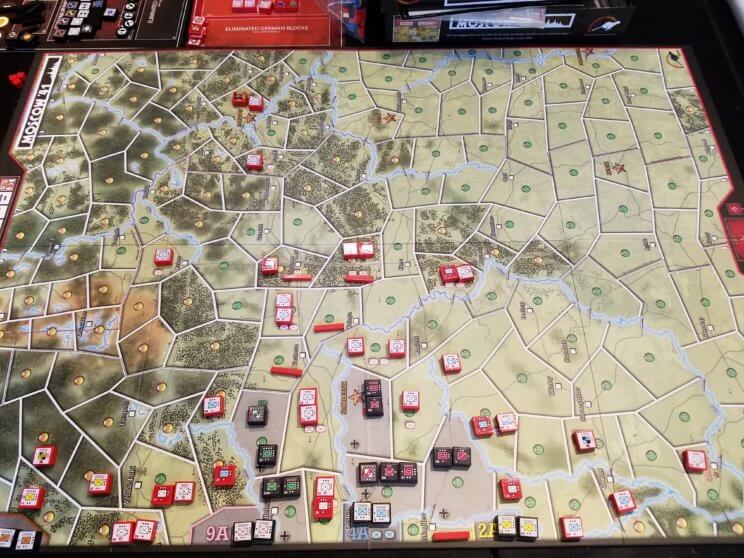
Shit…ok. Maybe I can attack without air? Was that a hint….what happens if I take reinforcements?
Let’s see.
Doah…I got to give up the initiative disk. That is a big deal in Waterloo 200. Is it a big deal here? Surely the Russkies will want reinforcements…..? Right?
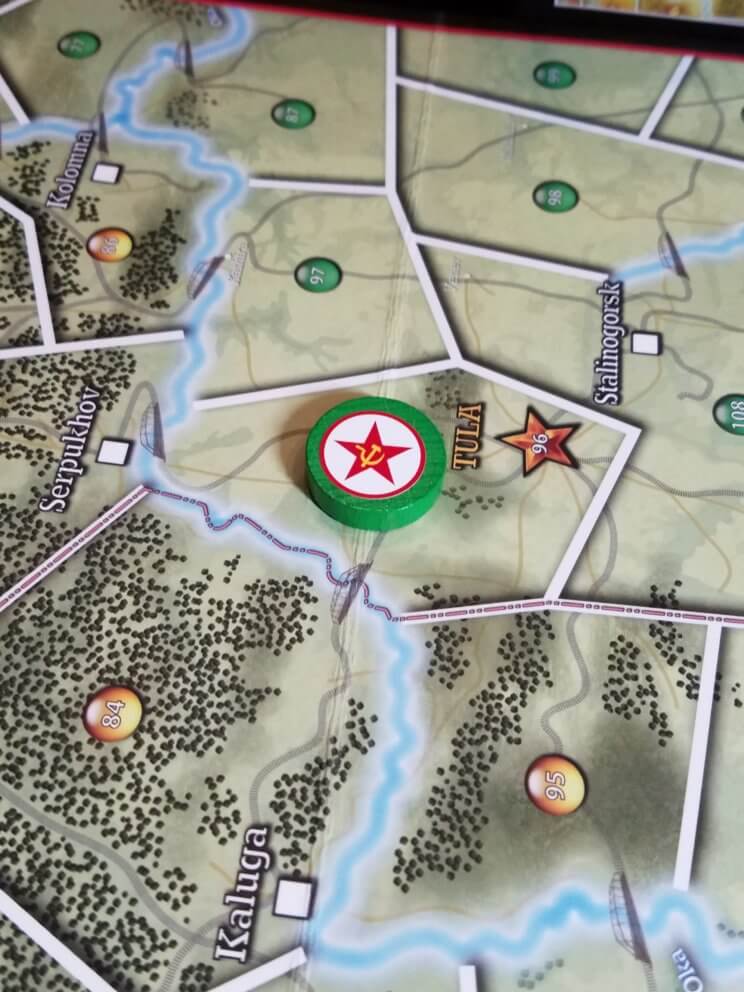
Ok here we go – Logistics Value of 8. Therefore 8 blocks are pulled for reinforcement:
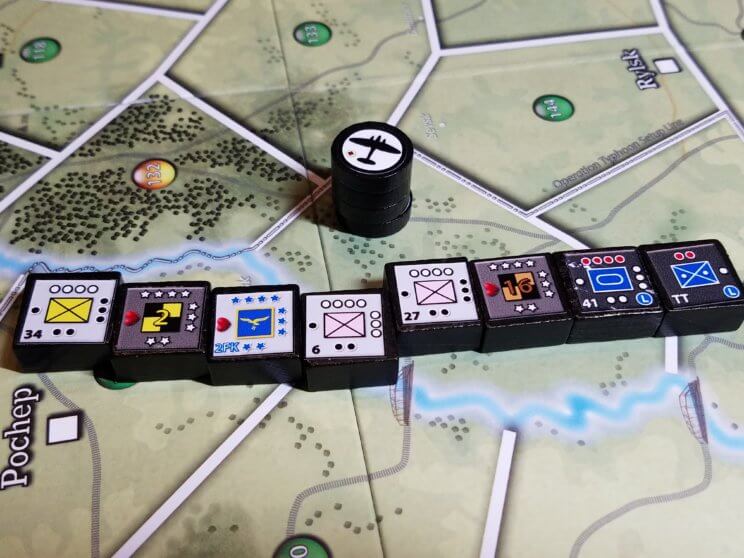
Ok.. a mish mash. AND a LUFT HQ!! – Loerzer and his He 111’s.
Note the 41st and Deaths Head SS [TT] on the right- they go to the Leningrad track. I have an early theory that breaking the flanks here is going to be key. So I am glad to have Hoepner’s two of three units on turn 1. In the South we want to release /capture Kiev early also forcing supply constraints and hard play choices on the Soviets.
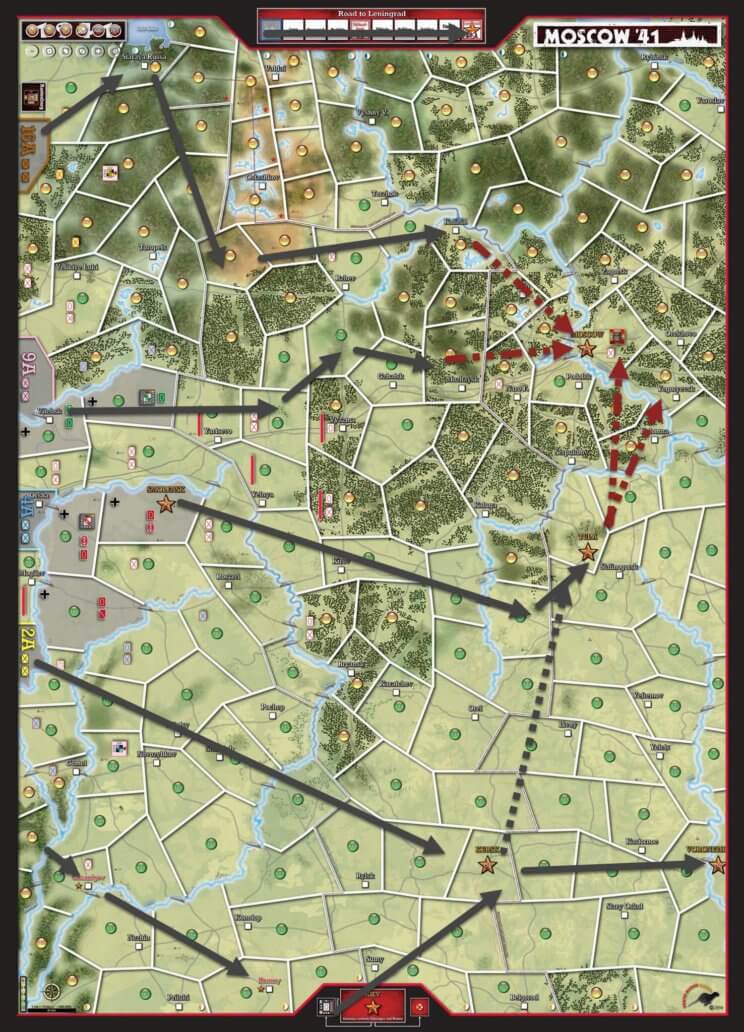
The setup now looks like so:
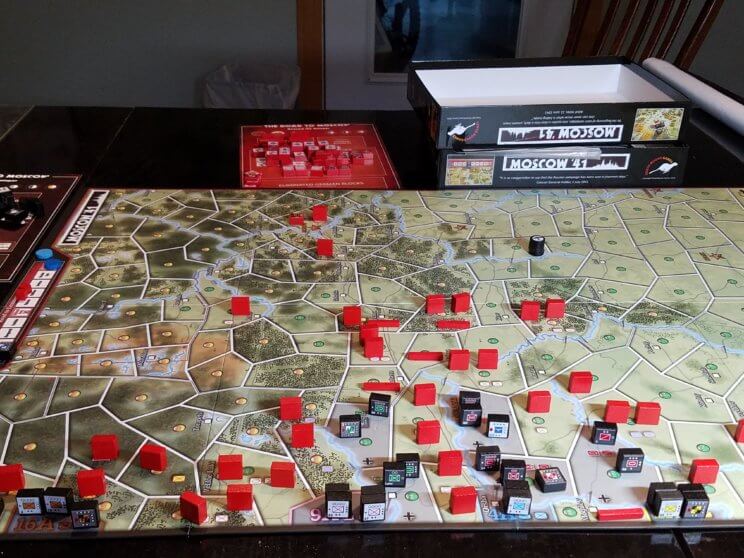
The Russians move back out of potential pockets in a tactical action versus taking reinforcements out of the gate.
In total the moves can be seen here – face down units moved:

More to come.
2 thoughts on “ Moscow ’41 ”
Don’t ever pass Initiative token early in the game. In my last two games German player never used it and it payed off. If you pass initiative token early in the game (turn 1 or 2) Russian player will be able to bring massive reinforcements (even up to 12-13 units) and it will be game killer for Germans.
I was looking at this! The only thing that would stop teh Russian from bringing on the initial 12 reinforcements is if they were under threat to lose a HQ. ( which they are).. I find it a but unreasonable to see NO AIR for the Germans at this stage of the game/war [I understand that motorrized had outstripped trailing units..but still]
Comments are closed.
Hunter 426 ds
The hunter 426 ds is a 41.83ft b&r designed by glenn henderson and built in fiberglass by hunter marine (usa) since 2003..
The Hunter 426 ds is a light sailboat which is a good performer. It is reasonably stable / stiff and has a good righting capability if capsized. It is best suited as a coastal cruiser. The fuel capacity is average. There is a good water supply range.
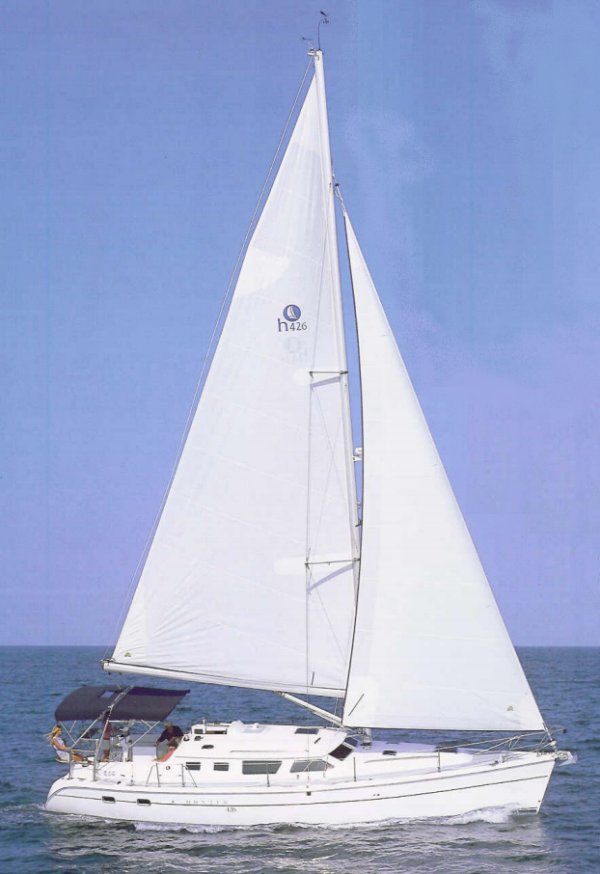
Hunter 426 ds for sale elsewhere on the web:

Main features
Login or register to personnalize this screen.
You will be able to pin external links of your choice.

See how Sailboatlab works in video

We help you build your own hydraulic steering system - Lecomble & Schmitt
Accommodations
Builder data, other photos.
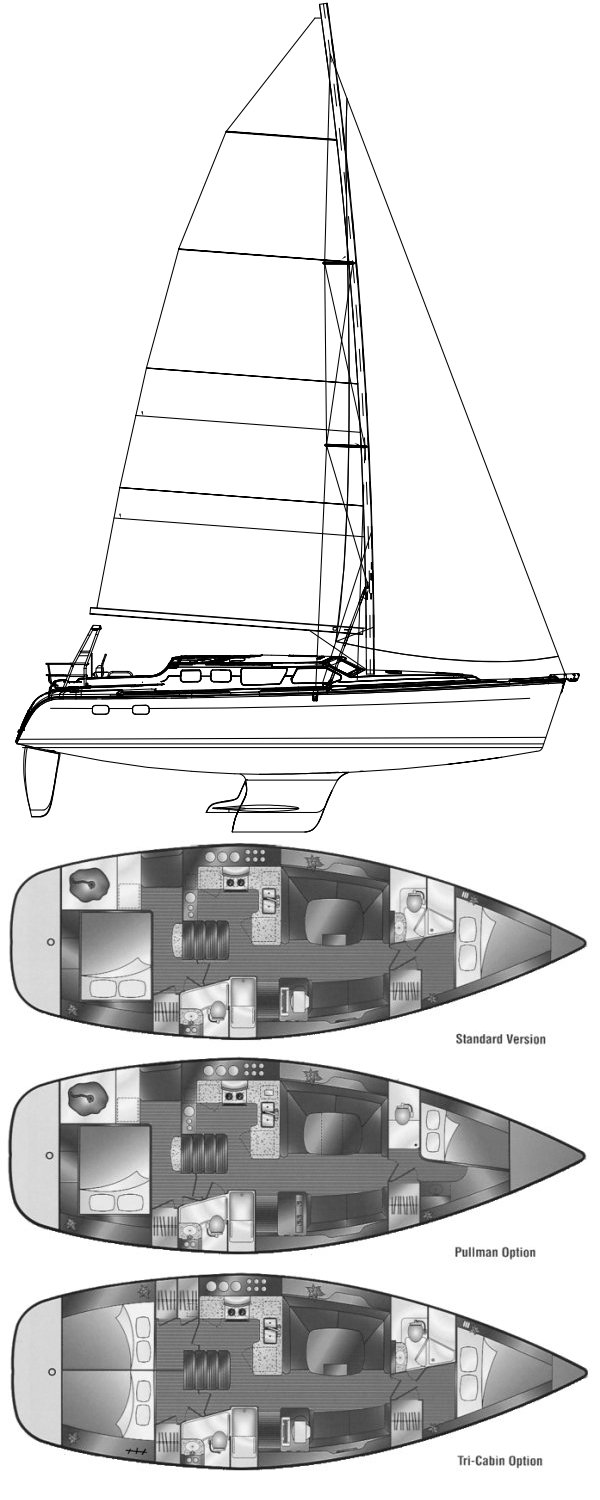
Modal Title
The content of your modal.
Personalize your sailboat data sheet

- New comments
- Military Photos
- Russian Military
- Anti-Aircraft
- SA-21/S-400 Triumf
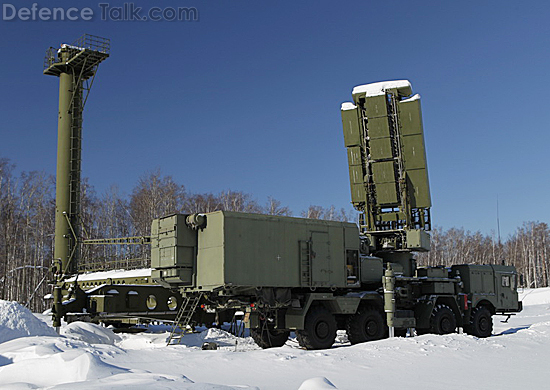
- May 8, 2011
Media information
Share this media.
- This site uses cookies to help personalise content, tailor your experience and to keep you logged in if you register. By continuing to use this site, you are consenting to our use of cookies. Accept Learn more…

IMAGES
COMMENTS
LENGTH: Traditionally, LOA (length over all) equaled hull length. Today, many builders use LOA to include rail overhangs, bowsprits, etc. and LOD (length on deck) for hull length. That said, LOA may still mean LOD if the builder is being honest and using accepted industry standards developed by groups like the ABYC (American Boat and Yacht Council).
Warren Luhrs, founder of Hunter Marine began in the boat building business, first with his father and brother at Henry Luhrs Sea Skiffs and then Silverton Sea Skiffs. Both companies were quite successful. Being an avid sailor, Luhrs had the idea of applying production line efficiencies to the sailing industry. In 1973, the first Hunter sailboat was launched. This was the HUNTER 25, designed by ...
For the Hunter 41 and 41 DS, he decided to push the Cp, a mathematical description of how full a boat is in the ends. "The extremes for sailboats are between .49 and .62," Henderson said, the higher figure equating to fuller ends. The higher the Cp, the more stable-and sluggish-the hull form. While trying to pick the ideal Cp at one ...
The Hunter 41 is an American sailboat that was designed by Glenn Henderson as a cruiser and first built in 2004. Production. The design was built by Hunter Marine in the United States between 2004 and 2012, but it is now out of production. The design was built in two variants, the Aft Cockpit (AC) and the Deck Salon (DS) models. ...
Hunter 41 AC. 2004 • 40′ 3″. Hunter 41 DS is a 40′ 3″ / 12.3 m monohull sailboat designed by Glenn Henderson and built by Hunter Marine starting in 2006.
The Hunter 41 ds is a 40.32ft b&r designed by Glenn Henderson and built in fiberglass by Hunter Marine (USA) since 2006. ... The data on this page has been derived from different sources but a significant part is attributed to sailboatdata.com. We thank them for their encouragements and friendly collaboration.
Since Hunter Marine is constantly devising new ways of increasing and maximizing interior volume, it seems only natural that the Hunter 41DS takes advantage of a deck-saloon layout to achieve a more open and airy accommodations plan. The DS has large elevated windows for panoramic views and a whopping 6-foot, 10-inch headroom in the saloon. The standard two-cabin version has a master stateroom
May 24, 2021. #4. Hunter 41 DS is a great boat. Sold mine a year ago after owning for 12 years. Docking can be dicey in a cross wind with a bow thruster, really dicey without one. Design of boat limits thrusters' tunnel diameter, so even with thruster docking can be interesting.
Warren Luhrs, founder of Hunter Marine began in the boat building business, first with his father and brother at Henry Luhrs Sea Skiffs and then Silverton Sea Skiffs. ... Source: sailboatdata.com / CC BY. Suggest Improvements 98 sailboats built by Hunter Marine. ... 2007 Hunter 41 Deck Salon $155,000 USD. Omaha, NE, US 1994 Hunter 26 ...
2004 Hunter 41 Aft Cockpit. US$124,500. ↓ Price Drop. US $974/mo. Lighthouse Yachting Ltd. | Jolly Harbour, Antigua and Barbuda. <. 1. >. * Price displayed is based on today's currency conversion rate of the listed sales price.
The starting price is $135,000, the most expensive is $155,000, and the average price of $145,000. Related boats include the following models: Passage 420, 380 and 34. Boat Trader works with thousands of boat dealers and brokers to bring you one of the largest collections of Hunter 41 boats on the market.
The Hunter 260 is a 26.25ft b&r designed by Rob Mazza/Hunter Design Team and built in fiberglass by Hunter Marine (USA) between 1997 and 2005. ... The data on this page has been derived from different sources but a significant part is attributed to sailboatdata.com. We thank them for their encouragements and friendly collaboration.
Also referred to as the Hunter 40 Legend. Shoal draft: 5.0′ Disp.: 17900 lbs. Bal.: 8400 lbs.
Moscow '41. Opening moves matter. So it seems. The shrink rip was fun. The components excellent. The stickering easy (latex stickers that can be moved removed for the OCD). Now with rules read we attempt to grok this game. First thing to note is that we skip the Logistics phase in Turn 1.
Russian emergency workers have recovered 41 bodies and two flight recorders from the wreckage of a plane that caught fire during an emergency landing in Moscow, officials said Monday as they ...
The Hunter 426 ds is a 41.83ft b&r designed by Glenn Henderson and built in fiberglass by Hunter Marine (USA) since 2003. The Hunter 426 ds is a light sailboat which is a good performer. It is reasonably stable / stiff and has a good righting capability if capsized. It is best suited as a coastal cruiser. The fuel capacity is average.
Draft for deep keel: 6.33'/1.93m See HUNTER 420 which appears similar.
S-400 606th Missile Air-Defense Regiment, Elektrostal, Moscow Region
At least 41 people have been killed after a Russian plane caught fire and made an emergency landing at an airport in Moscow.Survivors had less than a minute ...
LENGTH: Traditionally, LOA (length over all) equaled hull length. Today, many builders use LOA to include rail overhangs, bowsprits, etc. and LOD (length on deck) for hull length. That said, LOA may still mean LOD if the builder is being honest and using accepted industry standards developed by groups like the ABYC (American Boat and Yacht Council).
Deep Keel version: draft: 7′ Disp. 35661 lbs. Ballast 11216 lbs. Tall rig: P = 55.75′ Furling Main: E = 23.75′ Mast height for tall rig: 68.5′
LENGTH: Traditionally, LOA (length over all) equaled hull length. Today, many builders use LOA to include rail overhangs, bowsprits, etc. and LOD (length on deck) for hull length. That said, LOA may still mean LOD if the builder is being honest and using accepted industry standards developed by groups like the ABYC (American Boat and Yacht Council).